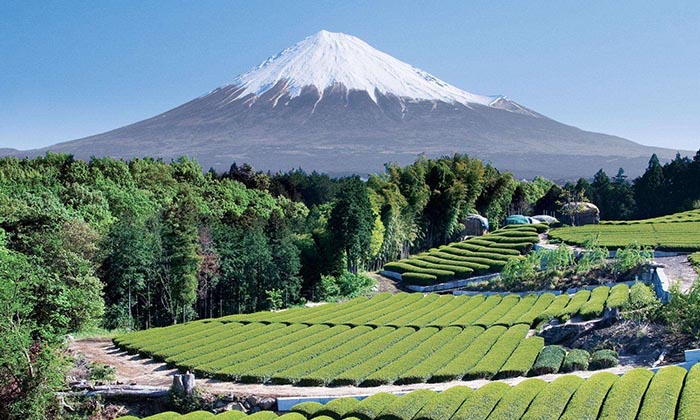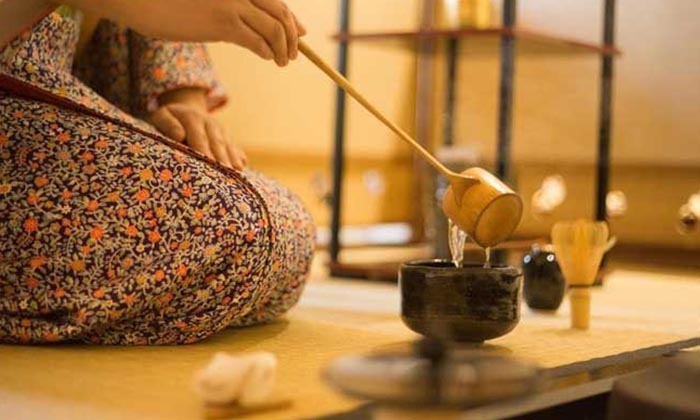Japanese Tea
Tea is the most common drink beverage in Japan and is an important part of Japanese culture. It was first introduced to Japan from China in the 700s. The most well-known places for tea cultivation in Japan are Shizuoka, Kagoshima, and Uji. Shizuoka is responsible for about half of Japan's tea production, but its specialty is sencha. Kyoto is famous for its high-quality teas, especially matcha and gyokoru. There are a variety of types of tea that are available and consumed in Japan. Unlike other nations, the most common type of tea the Japanese drink is green tea, which is what they mostly grow. Green tea is the main type of tea served at a tea ceremony.
Tea is served either hot or cold and can be found at all restaurants, vending machines, convenience stores, kiosks, and supermarkets. A few of the main varieties of tea that are popular in Japan include Ryokucha (green tea), Matcha (powdered green tea), Oolongcha (a type of Chinese tea), Jasmine-cha (tea with jasmine flowers), etc.

The tea ceremony procedure includes a course meal, followed by a bowl of thick tea, then ends with a bowl of thin tea. The host typically prepares the tea in front of the guests. The tea ceremony is practiced as a hobby now, and many venues that provide people with opportunities to try and experience Japanese tea ceremony in Tokyo or Kyoto. Different types of formality and authenticity are offered in hotels, gardens, and at culture centers. You can discover new aspects of Japanese culture by experiencing a Japanese tea ceremony.

As a reliable Japan travel agency, we are happy to provide you budget Japan group tours, and private car/limousine service, if you need more information on Tokyo tours, and Tokyo limousine service, please feel free to contact our specialists.
Tea is the most common drink beverage in Japan and is an important part of Japanese culture. It was first introduced to Japan from China in the 700s. The most well-known places for tea cultivation in Japan are Shizuoka, Kagoshima, and Uji. Shizuoka is responsible for about half of Japan's tea production, but its specialty is sencha. Kyoto is famous for its high-quality teas, especially matcha and gyokoru. There are a variety of types of tea that are available and consumed in Japan. Unlike other nations, the most common type of tea the Japanese drink is green tea, which is what they mostly grow. Green tea is the main type of tea served at a tea ceremony.
Tea is served either hot or cold and can be found at all restaurants, vending machines, convenience stores, kiosks, and supermarkets. A few of the main varieties of tea that are popular in Japan include Ryokucha (green tea), Matcha (powdered green tea), Oolongcha (a type of Chinese tea), Jasmine-cha (tea with jasmine flowers), etc.

Experience Tea Ceremony in Japan
The Japanese tea ceremony, also known as Sado or Chado, is one of the traditional Japanese cultural activities. It is a ceremonial way of preparing and drinking green tea in a traditional tearoom with a tatami floor. The Japanese tea ceremony began in the 16th century and the beauty of a tea ceremony is the quietness, and it is plain and elegant. As a Japanese traditional etiquette art, the main purpose of a tea ceremony is for the guests to enjoy the hospitality of the host and separate yourselves from the fast pace of everyday life.The tea ceremony procedure includes a course meal, followed by a bowl of thick tea, then ends with a bowl of thin tea. The host typically prepares the tea in front of the guests. The tea ceremony is practiced as a hobby now, and many venues that provide people with opportunities to try and experience Japanese tea ceremony in Tokyo or Kyoto. Different types of formality and authenticity are offered in hotels, gardens, and at culture centers. You can discover new aspects of Japanese culture by experiencing a Japanese tea ceremony.

As a reliable Japan travel agency, we are happy to provide you budget Japan group tours, and private car/limousine service, if you need more information on Tokyo tours, and Tokyo limousine service, please feel free to contact our specialists.
Related Articles You May Like
Most Frequently Asked Questions
-
Can you arrange a tea ceremony experience?We can arrange tea ceremony experience in Japan. We generally arrange the experience in Tokyo, Osaka, Kyoto, Nagoya, Shizuoka and other places. Depending on your itinerary, you can choose where to attend the tea ceremony performance.
-
What is Japanese tea ceremony?Japanese tea ceremony or matcha drinking ceremony is the tradition of serving tea after dessert. Japanese has specific rules during the experience, including how to make tea, pour tea, tea room design, and social etiquette between host and the guest. In Japanese, it is called chanoyu, sado, chadou or ocha.
-
What is the purpose of Japanese tea ceremony?The main purpose of the tea ceremony is to prompt the interaction between guest and the host and relieve our mind from busy daily lives. In fact, there are many more profound significance and benefits to tea ceremony in addition to the ones mentioned. From books on tea ceremony, meditation during the tea ceremony also an important aspect.
-
How long does a tea ceremony last?Depending on the types of tea ceremony (formal, casual, small group, or large group), the duration differs. For casual (chakai) or small group tea ceremony, the experience lasts about 30 min to an hour. For formal tea ceremony (chaji) during kaiseki, the tea ceremony can be up to 4 hours. Additional time might be required for guest changing clothes and waiting in tea garden.
-
What type of tea is used in the ceremony?Fresh powdered matcha leaves is commonly used in tea ceremony. The quality of the tea depends on whether the top or bottom leaves are used. The top 2 leaves picked during the first season are often the highest quality. In contrast, the bottom 5 leaves picked in third season are often the lowest quality. Roasted leaves are called hojicha.
-
What confections are served during the tea ceremony?There are generally 2 different sweets provided in tea ceremony. The first one is higashi, which is a dry confectionery made with rice flour in a wooden mold. The higashi are prepared in differently according to the season. In spring, for example, higashi are made in cherry blossom flavor; in fall, higashi will be made in maple leave shape. Higashi is usually used during chakai, casual tea ceremony. Monogashi is made a mixture of rice flour and flour, usually with some red bean paste inside. Similarly, Monogashi are also prepared differently in seasons.
-
What tea is used in Japanese tea ceremony?Green tea, oolong tea, and black tea are commonly used in Japanese tea ceremony. Green tea is unfermented tea, and its color remains green after processing. Oolong and black tea are fermented, and the colors range from brown to red.
-
What is East candy and Monogashi candy?East candy always changes in season, especially in spring (cherry flavor) and autumn (maple leaf candy). These sweets are for chakai informal gatherings only. Monogashi candy is moist candy. These candies are often a mixture of flour and rice flour on the outside and red bean paste on the inside. They also change with each season. Both kinds of sweets are served during the Japanese tea ceremony.
Japan Office
- Tel: +81 50-3701-6391
- Email: info@japanholiday.com
- Working Hours: 8am-7pm, (Japan)
USA Office
- Tel: +1-6265617117
- Email: info@japanholiday.com
- Working Hours: 8am-7pm, Pacific Time

